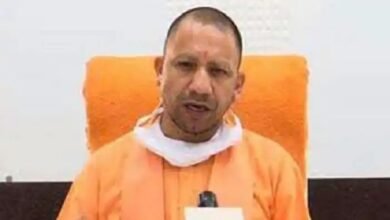[ad_1]
The Garhwal region of the Himalayas, which has seen loss of life and destruction due to flash floods in recent years, was once again in the news because 41 workers, who were trying to cut through the mountains to extend the Char Dham Yatra route, were trapped when part of a tunnel collapsed. The 17-day-long ordeal was, among other things, being ascribed to the wrath of the divine guardian of the area: Baba Baukh Nag. The broad narrative arc of the promotion and “development” of the ecologically fragile region to make it a “Devbhumi” could be summed up as a process of creeping colonisation of the hill regions by the mostly plains-based lobbies of politicians, policy planners and construction companies.
Developing Uttarakhand mountains as “Devbhumi” — an ideal destination for pilgrims and pleasure seeking tourists with easily traversable routes and homestays — has ended in burying local beliefs and lores about hundreds of non-sanatani local gods, demigods, goddesses, faeries, benign and demonic souls of mystics, exiled kings, warriors and tragically separated lovers. These tales have been an inalienable part of the area’s unique local culture. The local gods are believed to be ever present in the area to protect the thin local populations when natural disasters and earthquakes strike. They are quick to anger if neglected and bestow good luck when propitiated properly through unique local rituals. Baba Baukh Nag, a demigod from the nag pantheon, was believed to have been angered by the tunnel creators. They have not just touched but bored through His mountain without formally seeking his permission. Nag devtas are customarily worshipped all over the Garhwal and Kumaon regions. It is believed that the chief nag devta, Nagela, arrived with the Negi kings from Kumaon and first manifested himself in Garhwal in the body of a medium by the name of Jot Singh Rana. The area has always abounded in snakes but Nagela’s arrival took away the fear of being fatally bitten.
Baba Baukh Nag is believed to be one of Nagela’s avatars, but the erasing of the hill sides, it is believed, may have driven him beyond his saumya swaroop (benign form). He has since been honoured by the building company, which created a makeshift shrine at the mouth of the blocked tunnel. A video showed a village priest saying in awed tones how every one, including an international tunnelling expert, Arnold Dix, must bow and pray before entering the tunnel.
Truth be told, the culture or cultures that created the complex lores that prevented these fragile mountain sides from being defaced by humans, have long been appropriated and locked away by outsiders looking for a profit. They have proved to be foolishly dismissive of the geologists’ warnings as well, regarding the fragility of the Himalayas and the paradox of the “eternal” mountains in the area resting on a major faultline that makes it prone to devastating earthquakes.
The four famous shrines, the Char Dhams, actually came up as major pilgrimage spots only around the 10th century. In rural Uttarakhand, however, while people revere the shrines, they remain pantheists and animists at heart. Each village has a simple stone temple dedicated to an ancient local goddess and another to Bhumiya Devta (protector of forests and fields). Families have their own ishta devtas whose temples (thans) they visit at all major family occasions. In all these temples, there are seldom any recognisable idols. Just stones on which some rudimentary sketches have been made. There are countless prayer flags fluttering all around the hills, on trees and bells, to placate the goddesses and all three kinds of local devtas: Devangi (related to the bigger gods), rajangi (ideal kings who ruled the area once) and bhutangi (the highly strung and restless spirits roaming cremation grounds along the rivers). They are the ones that locals firmly believe will protect and heal them, in a way that the distant seats of power will not. The quick-witted, courageous intermediaries, the Dhamis, the Jagariyas and Pashwas, living in their midst are still sought out, even by non-resident Pahadis. They rush home to them when in trouble and offer puja to propitiate whichever god or goddess they may have offended.
Until India’s war with China in 1962, there were few motorable roads high in the mountains and very poor power and media connectivity. But for a few towns, like Nainital, Dehradun, Ranikhet or Lansdowne, developed by the British for their own comfort, the locals were mostly left to the mercy of their local gods and goddesses. Cut off from the mainland by the terrain, the economy of this remote region was forced to be largely self reliant. Good or bad harvests, and health, were also dependent on the pleasure or displeasure of the local gods.
In case of major or minor calamities ranging from epidemics to floods, fires or loss of cattle, people still gather here for jaagar, a musical ritual inviting the local gods with night-long singing of tales from the Mahabharata. Rituals are led by the priest (Dhami). During jaagar, one by one, the various local gods begin to manifest themselves through a medium, Pashwa, and answer questions. The possessed Pashwa mumbles or screams out in the voice of a god, expressing anger over being disrespected and not getting the usual gifts and animal sacrifices or someone having committed a crime or desecrated the area in some way. The tunnelling job was deemed as one such flouting of local custom — according to the locals and priests, that is a cognisable offence for Baba Baukh Nag, punishable by frequent machine malfunction and bad weather.
The key to understanding complex geopolitical origins and uncertain future of the Himalayan area lies in analysing not just scientific data but also looking at its neglected lores and sensible taboos. As the poet Bhupi Sherchan wrote, “This is a country of hearsay and rumour/ If one were to unearth the foundation of each house here/ only hearsay and rumour would be found heaped there/ That is why this is a country of hearsay and rumour.”
The writer is former chairperson, Prasar Bharti
[ad_2]




